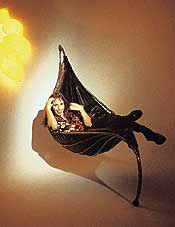
Photograph © Aqua Creations
Initially an artist who worked in the humble mediums of dust and rice paper, Ayala Sefarty’s multihued, multifaceted design career started while she was snorkeling in the Red Sea. Back on the beach, Sefarty immediately began to sketch the designs that would launch Aqua Creations, her nature-influenced furniture and lighting company. Almost 10 years later, Sefarty has an extensive product line and has branched out into designing casino and hotel interiors, as well as a 2,400-square-foot underwater restaurant in Eilat, Israel. Her latest installation is an enormous futuristic chandelier, composed of 50 lamps hung in the main entrance of an aquarium in Valencia, Spain.
You studied fine art in Jerusalem and in London. What led you to furniture design?
Ten years ago I was a fine artist, and making props to earn money. After my trip to the Red Sea, something happened to me. I realized that I was bored with my artwork. I began to design organic-shaped lamps and furniture and never stopped. Your work doesn’t seem to fit the “form follows function” credo. My designs are definitely functional, but for me, form follows fantasy. I’m trying to create something alive, humorous, and colorful—objects with texture and movement. So much of what one sees tends to be minimal or flat or square, so when I design I am not thinking in terms of everyday styles.
What materials do you prefer to work with?
With lighting projects I tend to work in silk, felt, or glass wrapped in fabrics. My newest lighting projects will involve a new material whose technology we’ve been working on for more than a year to develop. For the furniture, I use hand-dyed fabrics, and I am starting to use more wool.
If you could pick any building in the world to feature your designs, what would it be?
One of Gaudí, or a building that is very Japanese. In the Gaudí building, my designs would be natural, and in the Japanese, a harmony of oppositions.
What is your relationship with architects?
Architects are my best clients, because they often challenge me with unusual projects. I think they like to work with us because we can do custom work to suit their fantasy. When it’s a relationship of trust, as it has been working with the architect in the aquarium project in Valencia, it’s like a birthday party. It’s just so easy.
What are the pitfalls for designing an underwater restaurant?
There is the necessity to design the indoors to coexist with the aquatic outdoors. When diners are looking out the window, I didn’t want the reflection of the interior to clash with their view, so it was important to me to design pieces that would enhance their underwater experience.
How have your designs changed over the years?
The work is more cellular in structure, more refined, not as brightly colored, and more about topography. As a whole, I am more conscious of other pieces in the design of the room. In the past, I thought of each piece as a sculpture.
Who would you like to see sitting in your Satala chair [pictured]?
David Bowie. Or Eric Clapton.
